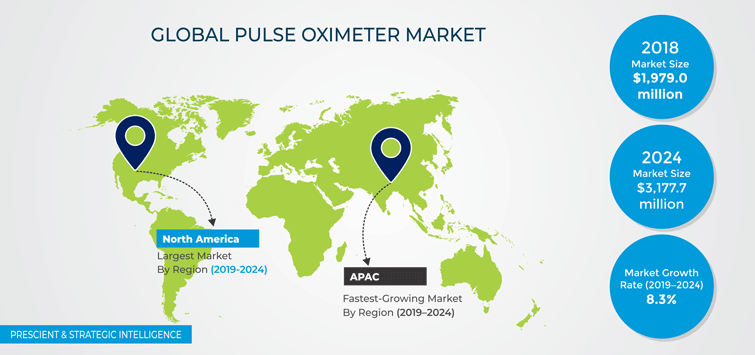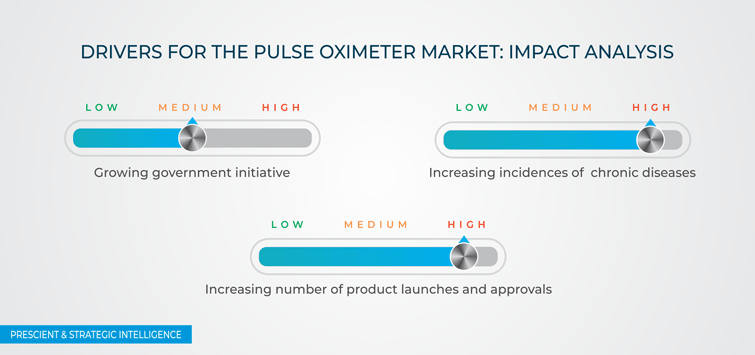Report Code: 11135 | Available Format: PDF | Pages: 236
Pulse Oximeter Market Research Report: By Type (Fingertip, Table-Top, Wrist-Worn, Hand-Held, Earlobe, Forehead, Palm/Foot, Nose), Sensor Type (Reusable, Disposable), Patient Type (Neonatal, Pediatric, Adult), End User (Hospitals, Clinics & Healthcare Facilities, Home Care, Diagnostic Centers), Geographical Outlook (U.S., Canada, Germany, France, U.K., Italy, Spain, Japan, China, India, Brazil, Mexico, Saudi Arabia, South Africa) - Industry Trends and Forecast to 2024
- Report Code: 11135
- Available Format: PDF
- Pages: 236
- Report Description
- Table of Contents
- Market Segmentation
- Request Free Sample
Valued at $1,979.0 million in 2018, the global pulse oximeter market is projected to generate revenue worth $3,177.7 million by 2024, witnessing a CAGR of 8.3% between 2019 and 2024.
Among all regions, North America is expected to lead the market during the forecast period. The presence of key manufacturers and high adoption rate of pulse oximeter devices for health monitoring across North America are the major factors driving the market. Moreover, the World Health Organization (WHO)’s surgical care program, which mandates the use of pulse oximeters in surgical procedures, and increased adoption of metabolic screening among patients are supporting the growth of the pulse oximeter market in North America.

Dynamics of Pulse Oximeter Market
The key trend being observed in the pulse oximeter market is the growing government initiatives. Pulse oximetry for anesthesia during surgery has been a standard of care in the developed as well as developing nations. Many government policies and programs were adopted to cater to the demand for pulse oximeters. For instance, in 2016, Koninklijke Philips N.V., Government of the Federal Democratic Republic of Ethiopia, Bill & Melinda Gates Foundation, and Masimo Foundation collaborated to support the Government of Ethiopia in providing medical oxygen and pulse oximeters for women and children. Therefore, the active participation by the government is expected to boost the market growth in the coming years.
With the integration of artificial intelligence in pulse oximeters, the demand for these devices is likely to increase in the home and hospital settings in the coming years. The market is growing with the rising usage of mobile-based platforms and wearable devices to ascertain the level of oxygen saturation in the patients. Further, advances in the microprocessor technology, along with improvements in light-emitting diodes and photoelectric sensors, have also enhanced the accuracy and reliability of pulse oximeters. Many companies are showing improved models and waving study results to accelerate the usage of pulse oximeters.

Pulse oximeters have emerged as a useful device in the evaluation of a patient’s oxygenation status and are therefore used extensively in various departments or units within healthcare settings. The demand for pulse oximeters is increasing on account of the different age groups of patients who are being admitted in hospitals and other settings. Pulse oximeters are needed by patients with cardiac arrest, multisystem trauma, apneic conditions, sickle-cell crises, and drowning incidents. These wide application areas of pulse oximeters are expected to drive their market demand in the future.
Pulse Oximeter Market Segmentation Analysis
Under the type segment, fingertip pulse oximeters held the largest share in the pulse oximeter market in 2018 with revenue of $293.2 million. The wrist-worn pulse oximeter category is expected to witness the fastest growth, at a CAGR of 10.6%, during the forecast period. The market growth dominance of this category can be attributed to the fact that wrist-worn oximeters are more advanced in terms of technology and are highly preferred by the geriatric population in home-based care.
On the basis of sensor type, reusable-sensor oximeters accounted for the larger market share in 2018. Unlike disposable-sensor variants, reusable sensor-based oximeters are designed for short-term, continuous monitoring and quick spot checks of oxygen level in patients. They also provide more-stable griping during monitoring as compared to disposable pulse oximeters.
On the basis of patient type, adult patients are projected to hold a 65.4% market share by 2024. The projected dominance is attributed due to the increase in the geriatric population globally.
Hospitals were the largest end-user of pulse oximeters, accounting for 36.5% market share in 2018. This end-user category is also expected to be the fastest growing in the pulse oximeter market during the forecast period.
Geographical Scenario of Pulse Oximeter Market
North America was the largest pulse oximeter market in 2018. In North America, the U.S held the largest market share, of 80.2%, in 2018, progressing with a CAGR of 7.6% during the forecast period. APAC is expected to be the fastest growing market during the forecast period on account of the growing pool of elderly patients, who are more prone to diseases and require pulse oximeters for regular monitoring of their condition.
China, which would be the fastest growing market for pulse oximeters in the APAC region and hold 33.5% market share by 2024. This is mainly due to the adoption of advanced technology and extensive expenditure in research and development activities. The advancements have led to the development of lightweight, patient-friendly, app-connected pulse oximeters in the country, which will further boost the growth of the Chinese pulse oximeter market in the coming years.
.png)
Competitive Landscape of Pulse Oximeter Market
Some of the giant players, which are extensively involved in the development of pulse oximeters, are Masimo Corporation, Edwards Lifesciences Corporation, Nihon Kohden Corporation, and General Electric Company. Some of the other players in market are Medtronic PLC, Koniklijke Philips N.V., Drägerwerk AG & Co. KGaA, Smiths Medical Inc., Opto Circuits Limited, Halma PLC, and Spacelabs Healthcare Inc..
Recent Strategic Developments of Pulse Oximeter Market Players
In recent years, major players operating in the global pulse oximeter market have actively engaged in strategic developments, such as product launches and regulatory approvals, to gain a competitive edge in the industry. For instance, in January 2019, Masimo Corporation announced the launch of its Iris Device Management System (Iris DMS), an automation and connectivity solution, which is designed to streamline the management of its pulse oximeter devices in a hospital.
Furthermore, in March 2019, Masimo Corporation, another key pulse oximeter market player, received the U.S. Food and Drug Administration clearance for its RAD-67 pulse co-oximeter. The device is also equipped with spot-check next-generation SpHb monitoring technology and the rainbow DCI-mini Reusable Sensor. The device provides portable spot-check monitoring measurements of oxygen saturation, which makes it a single-device solution in multiple clinical and non-clinical settings.
Key Questions Addressed in the Report
- What is the current scenario of the global pulse oximeter market?
- What are the emerging technologies for the development of pulse oximeter?
- What are the key market categories and their market size and future potential?
- What are the major key catalysts for the market and their impact during the short, medium, and long terms?
- What are the evolving opportunities for the players in the market?
- Which are the key regions from the investment perspective?
- What are the key strategies being adopted by the major players to expand their market share?
The pulse oximeter market would generate revenue of $3,177.7 million by 2024.
The pulse oximeter industry is predicted to exhibit a CAGR of 8.3% from 2019 to 2024.
In 2018, the pulse oximeter market had a value of $1,979.0 million.
The adoption of artificial intelligence (AI) in these instruments would push up the sales of pulse oximeters across the globe in the coming years.
The implementation of favorable government initiatives regarding these devices is the biggest trend currently being witnessed in the pulse oximeter industry.
Want a report tailored exactly to your business strategy?
Request CustomizationWant an insight-rich discussion with the report author?
Speak to AnalystOur dedication to providing the most-accurate market information has earned us verification by Dun & Bradstreet (D&B). We strive for quality checking of the highest level to enable data-driven decision making for you
Our insights into the minutest levels of the markets, including the latest trends and competitive landscape, give you all the answers you need to take your business to new heights
With 24/7 research support, we ensure that the wheels of your business never stop turning. Don’t let time stand in your way. Get all your queries answered with a simple phone call or email, as and when required
We take a cautious approach to protecting your personal and confidential information. Trust is the strongest bond that connects us and our clients, and trust we build by complying with all international and domestic data protection and privacy laws